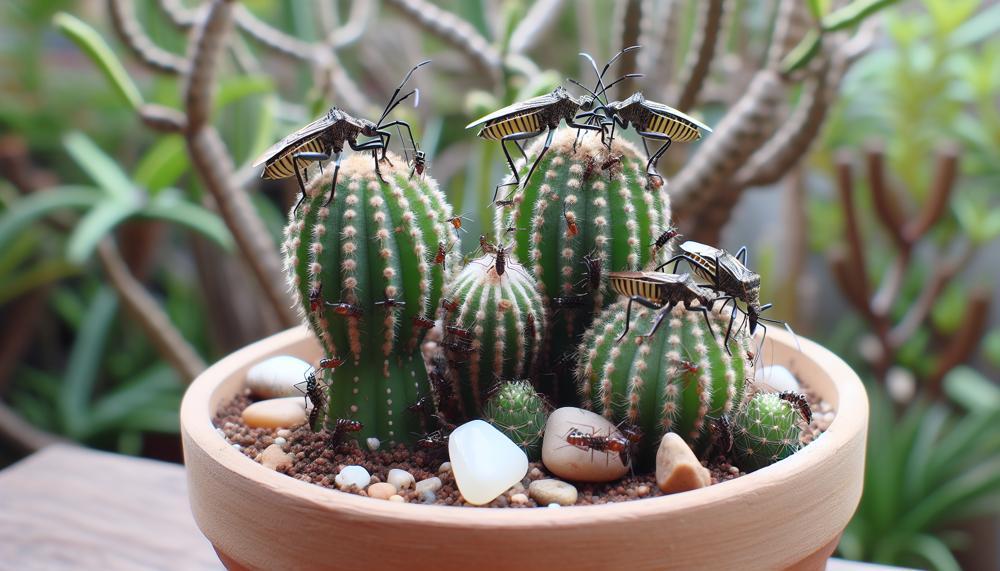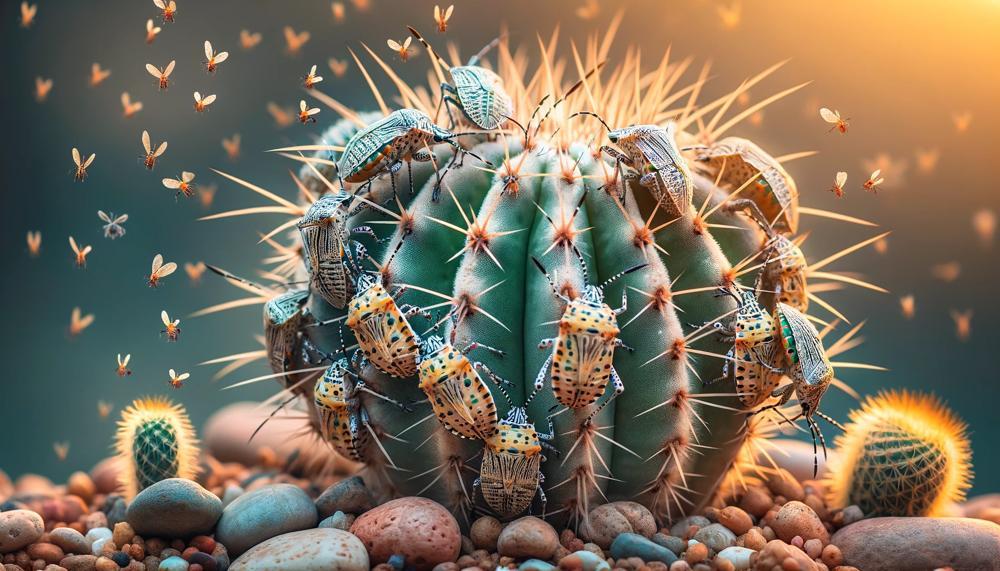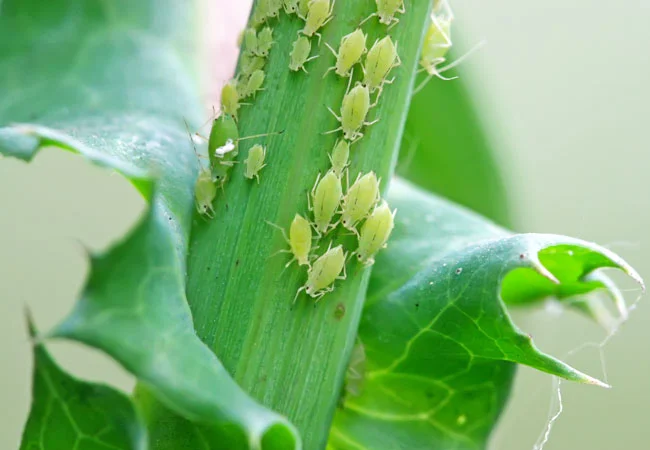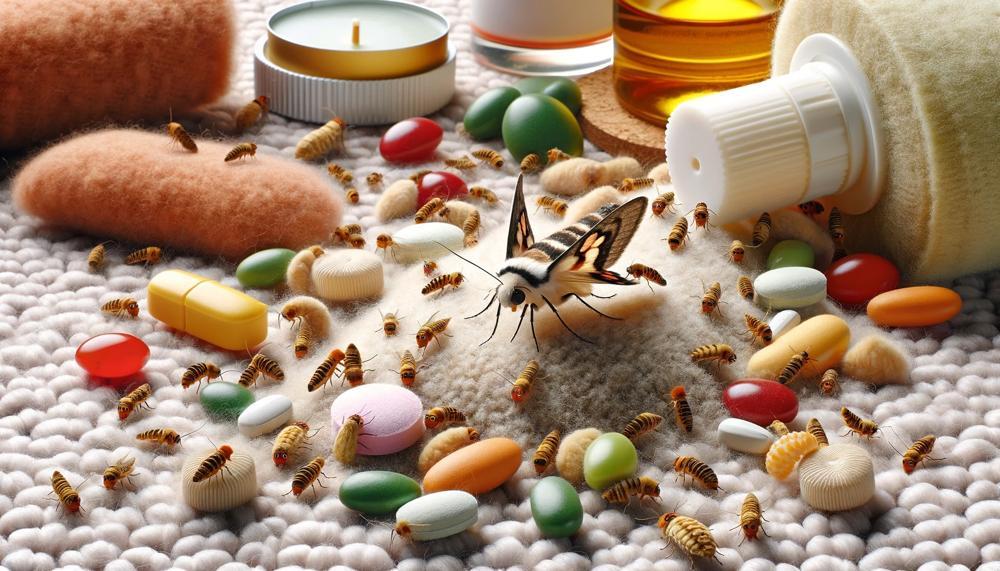If you’ve noticed your beloved cacti starting to look a bit under the weather, with unusual spots or the presence of tiny, unwelcome guests, you’re in the right place. Cactus bugs, though small, can pose a big problem for your prickly pals.
Before you reach for chemical solutions, let’s explore the world of natural remedies that can help keep your cacti happy, healthy, and bug-free.
In this guide, we’re diving deep into the eco-friendly arsenal against those pesky cactus bugs.
So, how do you get rid of cactus bugs naturally?
Here are some natural ways to get rid of cactus bugs:
- Dry out the soil: Let the soil dry out for about two weeks, then the eggs and larvae will shrivel up and the adults will die.
- Use insecticidal soapl: Mix two tablespoons of castile soap with one gallon of water in a spray bottle, then spritz the leaves every two to three days for at least two weeks.
- Use diatomaceous earthl: This powder kills any insect that crawls across it, but won’t harm your cactus.
- Use neem oill: Neem oil contains Azadirachtin, which repels insects like aphids, mealy bugs, mites, whiteflies, and Japanese beetles. It also works against fungal diseases like rust fungi, powdery mildew, and black spot.
- Prunel: Prune all affected parts of the plant to prevent re-infestation.
- Waterl: Moisten the leaves daily with water to make them uninhabitable for hydrophobic bugs.
- Introduce natural enemiesl: Beneficial insects like lacewings, spiders, ladybugs, parasitic wasps, and minute pirate bugs prey on mealybugs.
- Plant natural aphid repellentsl: Grow garlic, chives, onion, or catnip around your garden to stop new aphids and other insects from nesting.
Let’s keep those cacti thriving with a little help from Mother Nature.
So, let’s get started.
Table of Contents
What’s eating my cactus?
Identifying the signs of a cactus bug infestation early on is crucial to saving your beloved plants from irreversible damage.
Cactus bugs, particularly scale insects, are crafty little pests that feast on the sap of your plants, leading to a slew of problems if not tackled promptly. Here’s how you can spot these unwelcome guests:
| Visible Pests | Scale insects often appear as small, oval-shaped nuisances on your cactus. They’re usually found clumped together in colonies, making certain parts of the plant look unusually bumpy or coated in tiny shields. |
| Discoloration | Affected areas may show signs of yellowing or other discoloration due to the loss of sap. This sapping of vital fluids can cause parts of the plant to appear sickly or less vibrant than usual. |
| Sticky Residue | As these critters dine on your cactus, they excrete a sticky substance known as honeydew. This goo can attract other insects or foster sooty mould growth, which looks like a black or dark green powdery coating on the plant surfaces. |
| Poor Plant Health | If your cactus starts showing signs of weakness, drooping, or stunted growth without any apparent reason, it might be under siege from scale insects. These symptoms often indicate that the plant is losing too much sap and struggling to maintain its health. |
| Ant Activity | Increased ant activity around your cactus can also be a tell-tale sign. Ants are drawn to the honeydew left by scale insects and can often be seen milling about infested plants. |
Armed with this knowledge, you’re now better prepared to spot these stealthy invaders and take action. Remember, the sooner you detect an infestation, the easier it will be to manage and eliminate it.
Keep an eye out for these signs and don’t hesitate to employ natural remedies such as pruning affected areas, using rubbing alcohol, applying neem oil, sprinkling diatomaceous earth, or introducing natural predators like ladybugs and lacewings to help protect your cacti from harm.
Common cactus bugs
Homeowners with a green thumb and a love for their spiky, desert-dwelling plants should keep an eye out for a few crafty critters known to fancy cacti. From the sap-sucking aphids to the shell-armored scale insects, these pests can turn your prickly pals into their personal diners if left unchecked.
| Pest | Identifying Characteristics | Quick Tip |
| Aphids | Small, pear-shaped bugs in shades of green, yellow, or black; often found in clusters. | Look for a sticky residue on leaves or stems, which is aphid secretions. |
| Cactus Coreids (Cactus Bug) | Large, elongated bugs with a distinctive smell; brown or green in color. | Check for chewed or damaged areas on your cactus, especially on new growth. |
| Fungus Gnats | Tiny, dark-colored flies hovering around the soil surface of potted plants. | Overwatering attracts them; let the soil dry out between waterings as a deterrent. |
| Cactus Longhorn Beetles | Large beetles with long antennae; black, gray, or brown in color. | Inspect for holes in the cactus flesh where these beetles might have burrowed. |
| Mealybugs | Small, soft-bodied insects covered with a white, cottony substance. | Check leaf joints and under leaves for cotton-like clusters. |
| Scale Insects | Varies in color; appears as small bumps along plant stems and leaves. | Gently scrape a suspected bump; if it’s scale, it will come off easily. |
| Spider Mites | Tiny spider-like pests; may cause webbing on plants in severe infestations. | Look for fine silk webbing and tiny white or yellow speckles on leaves. |
Each of these pests has its own peculiar way of making life tough for your cacti. Early detection is key to keeping your plants healthy and vibrant. When you notice any unusual signs, such as discoloration, sticky residues (hello aphids.), or unexpected guests lounging on your plants, it’s time to take action.
How do you kill cactus bugs?
The battle against cactus bugs in your domicile can be as prickly as the plants they infest. There are several natural methods to show these little blighters the door, without resorting to harsh chemicals. Here’s how you can reclaim your green sanctuary:
Manual Removal:
The first line of defence is a good old fashion manual removal. Arm yourself with a soft cloth or a cotton swab steeped in rubbing alcohol and go on a bug hunt. Be thorough, as these critters are masters of hide and seek.
Neem Oil: A Plant’s Best Friend
| Method | Instructions | Frequency |
| Neem Oil Spray | Mix a few drops of neem oil with water and spray liberally on affected areas. | Once a week until pests are eliminated. |
Diatomaceous Earth: The Sharp Shooter
| Application Area | Method | Maintenance |
| Cactus Soil | Sprinkle diatomaceous earth avoiding direct contact with the plant. | Reapply regularly, especially after watering. |
Enlist the Bug Brigade
Introducing beneficial insects like ladybugs or lacewings into your home may seem like opening Pandora’s box, but it’s a natural and effective way to reduce cactus bug populations. They’re nature’s own pest control agents.
How to keep bugs away from your cactus
To fend off bugs from your cactus naturally, you’ve got a handful of strategies up your sleeve. Here’s how you can keep your prickly friend happy and pest-free without reaching for the chemicals.
| Method | Description | Frequency |
| Neem Oil Spray | Mix neem oil with water and spray on cactus. | Weekly |
| Beneficial Insects | Release insects like ladybugs or lacewings onto your cactus. | As needed |
| Diatomaceous Earth | Apply around the base of your cactus. | After detecting bugs |
| Inspections and Cleaning | Regularly check for bugs and clean with rubbing alcohol if needed. | Daily to Weekly |
Armed with these tips, your cactus will stand tall, proud, and bug-free. Just remember, persistence is key, and so is regular care. Keep at it, and those pesky invaders won’t stand a chance.
How do I get rid of the white stuff on my cactus?
The white stuff on your cactus could either be a sign of pest infestation, commonly mealybugs, or a fungal condition like powdery mildew. Both are unwelcome visitors, but fret not, as they can be tackled with some savvy, natural methods.
| Problem Type | Identification | Natural Removal Method |
| Mealybugs | Look for tiny, white, cotton-like clumps nestled in the nooks and crannies of your cactus. | Use a cotton swab soaked in a mix of water and rubbing alcohol (50:50 ratio) to dab and remove the bugs. Repeat every few days until clear. |
| Powdery Mildew | A white or grey powdery substance spreading on the surface of the cactus. | Spray with a solution of water and vinegar (40:60 ratio), ensuring to lightly mist the affected areas. Neem oil is also effective. |
| Preventive Care | Regular inspection for early signs. | Maintain good air circulation around your cactus and avoid overwatering. Neem oil can act as a preventive measure against pests and mildew. |

Remember, quarantine the afflicted cactus at the first sign of trouble to prevent any spread to your green comrades. Natural remedies like neem oil not only help in getting rid of these pests but also serve as a deterrent for future invasions when used regularly.
Additionally, ensuring your cactus has proper lighting and ventilation goes a long way in keeping it healthy and less susceptible to issues.
How to treat cochineal scale on cactus
To tackle cochineal scale on cactus plants without resorting to harsh chemicals, a handful of natural remedies can be particularly effective. Here’s a breakdown of these methods:
| Method | How It Works | Application Tips |
| Rubbing Alcohol | Dissolves the insects’ protective waxy coating, leading to dehydration and death. | Dilute with water in a spray bottle (50/50 ratio) and spritz directly onto affected areas. Avoid using in direct sunlight to prevent plant damage. |
| Neem Oil | Acts as a natural insecticide by suffocating the pests and disrupting their life cycle. | Mix with water as per package instructions and spray on affected areas weekly until infestation clears. |
| Natural Predators | Ladybugs, lacewings, and parasitic wasps feed on cochineal scale, helping control their population. | Purchase online or from garden centers and release near affected plants, following supplier guidelines for best results. |
| Dish Soap Solution | Breaks down the insects’ waxy exterior, causing dehydration and death. | Mix a few drops of dish soap with water in a spray bottle and apply to infested areas. Use sparingly to avoid harm to the plant. |
| Proper Care and Hygiene | Prevents and controls infestations by reducing conditions that favour pest proliferation. | Regularly inspect plants for pests, remove damaged parts promptly, avoid overwatering, and ensure good ventilation and spacing between plants. |
Each of these methods offers a safe and environmentally friendly way to deal with cochineal scale on your cacti. Remember, patience is key; it may take some time to see significant results. Additionally, combining one or more methods can enhance effectiveness.
Always test any treatment on a small area of your plant first to ensure it doesn’t react adversely.
How to get rid of coreid bugs
Getting rid of cactus bugs and preventing future infestations naturally involves a combination of tactics, from manual removal to employing the help of beneficial insects.
| Method | Description | Application Tips |
| Manual Removal | Physically wiping off bugs using a soft brush or cloth. | Inspect plants regularly, especially hidden areas, for thorough removal. |
| Neem Oil | A natural insecticide that repels and kills bugs. | Mix one teaspoon of neem oil with one quart of water and spray on plants. |
| Diatomaceous Earth | Fossilized remains of diatoms that dehydrate bugs. | Sprinkle around the base of plants and in affected areas. |
| Essential Oils | Natural repellents like peppermint, lavender, and eucalyptus. | Mix a few drops with water and spray on plants to deter bugs. |
| Beneficial Insects | Natural predators like ladybugs, lacewings, and praying mantises. | Release near infested plants to control bug population. |
| Cleaning and Pruning | Removing debris and dead leaves to discourage infestations. | Regularly clean and prune plants to prevent bug habitats. |
| Natural Repellents | Plants with repellent properties like chrysanthemums and garlic. | Plant these around your cacti to create a protective barrier. |
Did you get rid of the cactus pests?
Absolutely, tackling cactus pests naturally is both doable and wise.
Let’s dive into the nitty-gritty of beating these unwelcome guests without resorting to chemicals.
Neem Oil: A Natural Champion
| What It Does | Disrupts pests’ life cycle, making it hard for them to reproduce and survive. |
| How to Use | Mix with water and spray onto affected areas bi-weekly until pests bid adieu. |
Soap and Water: Simplicity Works
| Effectiveness | Great against mealybugs, spider mites. They can’t stand the breakdown of their exoskeletons, leading to dehydration. |
| Recipe | A tablespoon of dish soap in a gallon of water. Spray directly on pests. |
Beneficial Insects: Let Nature Do Its Thing
| Insects to Invite | Ladybugs, Lacewings, Praying Mantises. They’re the good guys here. |
| Why They Help | They feast on the very pests troubling your cacti. It’s a win-win. |
Prevention and Care: An Ounce of Prevention
- Inspect Regularly: Catch those pesky critters early.
- Proper Watering: Over or under-watering invites pests.
- Fertilization: Healthy plants can fight off pests better.
For those stubborn infestations, consider natural pesticides like pyrethrum or diatomaceous earth. They’re like the bouncers at the door, ensuring pests don’t crash your cactus party.
Remember, it’s all about balance. By employing these methods, you’re not just eradicating pests; you’re nurturing a thriving environment for your cacti. So yes, you can effectively and naturally eliminate pests from your cactus plants. Keep a keen eye, be patient, and let nature back you up in this fight.





